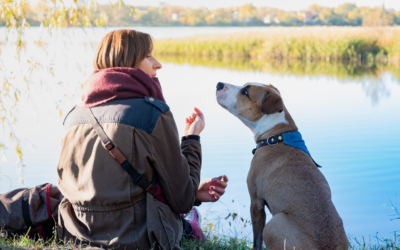There are five general ways that your dog can learn a new behaviour. Using the tricks below, you can start to train your dog almost any behaviour.

Social learning
Dogs have the ability to learn by observing others. Early in life, puppies learn from their litttermates and their mother. There have been studies that have shown that dogs can learn from humans. They will follow hand motions or other cues, as you may have noticed with your own dog. Recent research has also shown this happens between dogs. A dog watching another dog performing a new task can learn much more quickly that those that had not observed another dog.
If you have more than one dog, you may have noticed that a new dog coming into the household learns many of the routines and behaviour expected from another dog in the household. This unfortunately can also happen with unwanted behaviour. To benefit from this type of learning, allowing dogs to observe each other during training sessions might speed up their training process.
Modelling
Modelling is a form of dog training was popular many years ago, but is rarely seen in modern dog training. With this method, the dog is physically moved into the behaviour or position you want them to perform. For example, if you wanted to train your dog to sit, you would hold their collar while pushing down on their hind end.
This technique may eventually result in your dog sitting on command. However, it is not the most effective method of training. Your dog would likely push against your hand, so pushing up rather than the motion we'd be looking for. Your dog is also likely paying attention to the pressure on their body, and not the final movement (the sit) that is being accomplished.
As well, your dog needs to be within reach in order to train any behaviour with this method. This means that you need to be right beside your dog to train them. Physically moving an animal into position can also be a negative experience for the dog, so they may not enjoy training as much.
Luring
Luring is one of the easiest ways to get your dog to perform a behaviour. It is commonly used in puppy and obedience classes. This happens when you have a treat in your hand and move it to guide your dog to move a certain way. For example, if you want your dog to sit from a standing position, you’d move your hand (holding a treat) slightly behind or above your dogs head in an attempt to get them to back up slightly and put their hind end on the ground.

This method of training is useful for behaviours where you can use your hand motion to get your dog to move into a certain position. However, since your dog is following your hand motion and a treat, they sometimes aren’t paying attention to the behaviour THEY are performing. An excited puppy may follow your hand and treat twenty times into a sit position but not realize they are physically moving their body into a sit.
Many dogs have been successfully trained using this method. With repeated training, it will work to get your dog to perform many of the basic behaviours you’d like them to!
Capturing
In this method, you ‘capture’ your dog freely performing a certain behaviour and reward them for it. Capturing a behaviour is a very effective way to train a new behaviour, but requires quite a bit of skill. For example, you pet your dog every time they happen to come sit beside you on your left side – they’re then more likely to perform that behaviour.
One of the problems with capturing is that the person needs to have really good timing. If a dog sits and then stands and you reward them, but were wanting to work on a sit, then the dog will be confused as they’ll associate the reward with the last behaviour, or last string of behaviours, performed.
Clickers are often used when capturing behaviour as they allow the dog to know exactly when they’ve performed the right behaviour. It is a quick, distinct noise, and then allows you to have the time to get a treat out to reward your dog or bend down to pet them.
Shaping
Shaping a behaviour is the most complicated, but fun, method of getting a behaviour. This method involves using successive approximations to get a new behaviour. This means gradually rewarding movements that get closer and closer to the final behaviour that you’re trying to get.
If you were trying to get your dog to go over to their mat and lie down, you could reward the following steps:
1. Your dog looks towards the mat
2. Your dog takes a step towards the mat
3. Your dog takes several steps towards the mat
4. Your dog steps on the mat
5. Your dog puts all four feet on the mat
6. Your dog lies down on the mat
7. Your dog relaxes lying on the mat
This is a very simple example, but this method can be used to train quite complicated behaviours or series of behaviours. Dogs that have been trained using shaping also start to try many different behaviours. When they know that you’re in a training session they'll often try to figure out what you’d like them to do.
Using these five methods, you can train your dog almost any behaviour!



